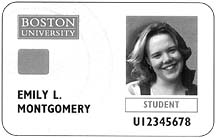![]()
Departments
![]()

|
Week of 20 February 1998 |
Vol. I, No. 21 |
Feature
Article
Pilot program at BU to introduce microchip card
A newer, smarter ID
by Brian Fitzgerald
Get ready to smile for the camera: in April, Boston University will start the process of switching to a new high-tech picture identification card that will make life more convenient and secure for students, faculty, and staff. By September, everyone in the BU community will own a new "Terrier" ID card.
There will be plenty of other reasons to smile as well.
The new IDs will be more attractive, durable, and easier to
create and reuse than the current laminated cards. "They
will also eliminate both the use of entitlement stickers and
the use of Social Security numbers as ID numbers," says
Marvin Cook, BU's vice president of planning, budgeting, and
information and chairman of the steering committee for the
new ID card project.
|
|
|
|
|
|
|
|
And many of the cards will not only look smarter than the old ones, they'll really be more intelligent: a pilot project at the University in the spring will feature the "smart card," which contains a computer microchip that has 100 times the storage capacity of the current magnetic stripe card. Approximately 1,300 students on South Campus will be given these microchip cards, which can be used for vending and laundry machines, copiers, and to purchase meals.
"The chip provides a powerful platform for future applications at Boston University," says Housing Director Marc Robillard, who points out that in the not-so- distant future, smart cards will become a standard part of everyone's daily life in the United States. "At present there are 800 million of them in use -- mostly in Europe," he says, noting the prevalence of microchip phone cards there. And companies such as IBM, Visa, MasterCard, and AT&T are devoting significant resources to the development of such cards. Alltel Stadium, home of the NFL's Jacksonville Jaguars, for example, uses this technology to speed up concessions purchases.
Microchips combine processing, logic, memory, and certain discrete functions into a complete system. "It's a miniature computer on a chip," says Robillard. "We want to know how BU students accept it."
Colleges where smart cards are currently in use include Pennsylvania State University, Villanova University, the University of Michigan, and Florida State University. "Most of the smart cards are at large universities that have strong debit programs like Boston University's," says Associate Housing Director Kathryn McGinn about BU's Convenience Points program, which students use to buy food from dining halls and necessities from Campus Convenience stores, along with books, clothing, and other items at Barnes & Noble at Boston University. In the Convenience Points program a magnetic stripe on the back of the card serves as a "purse," recording the purchases and indicating how many points are left on the card. One point is worth one cent.
"The new ID card amounts to better customer service," says University Registrar Florence Bergeron, who points out that with digitized photographs on a central database, lost IDs could be replaced almost instantly at any one of the five "carding stations" that are planned at BU. At present there is only one location at which to obtain ID cards and buy Convenience Points: the lower level of the George Sherman Union. But that will soon change. Assistant Registrar Melissa Janot says that carding stations will be installed this fall at the Registrar's Office, the Office of Housing, the Office of Personnel, and at a site on the Medical Campus. "A student or employee at the School of Medicine will be able to replace his or her lost card without having to come all the way over to the Charles River Campus," she says. The University is also considering the possibility of building several kiosks for buying Convenience Points and replacing lost cards.
The new microchip-reading equipment is being installed and tested on South Campus, which has coin-operated vending and laundry machines that are not on BU's online card network. "It wouldn't have been convenient or cost-effective to add the old magnetic stripe readers to South Campus," says Maxine Howe, director of application services at BU and chairperson of the task force that developed the new card.
South Campus residents, long accustomed to filling their pockets with quarters on laundry day -- while fellow students in other areas use Convenience Points -- will now get the technological jump on their classmates with smart cards.
But for the majority of the BU community, the most important and noticeable change on the new card, aside from its improved appearance, will be the disappearance of Social Security numbers. "Throughout the country, the misuse of Social Security numbers has increased in recent years," says Executive Personnel Director Manuel Monteiro. "The Social Security number on the face of the card has been a concern for some time. It's possible to create an identity with a stolen Social Security number or ruin someone's credit." For years the Registrar's Office has been creating unique identification numbers for students upon request, and the Office of Personnel has been doing the same for employees. "The new ID number will help protect the confidentiality of one's Social Security number," says Monteiro.
Furthermore, fewer colleges and universities still use the old laminated ID cards, with Polaroid photos and stickers that tend to peel off in wallets. "I think the new card helps improve the University's image," says Howe.

